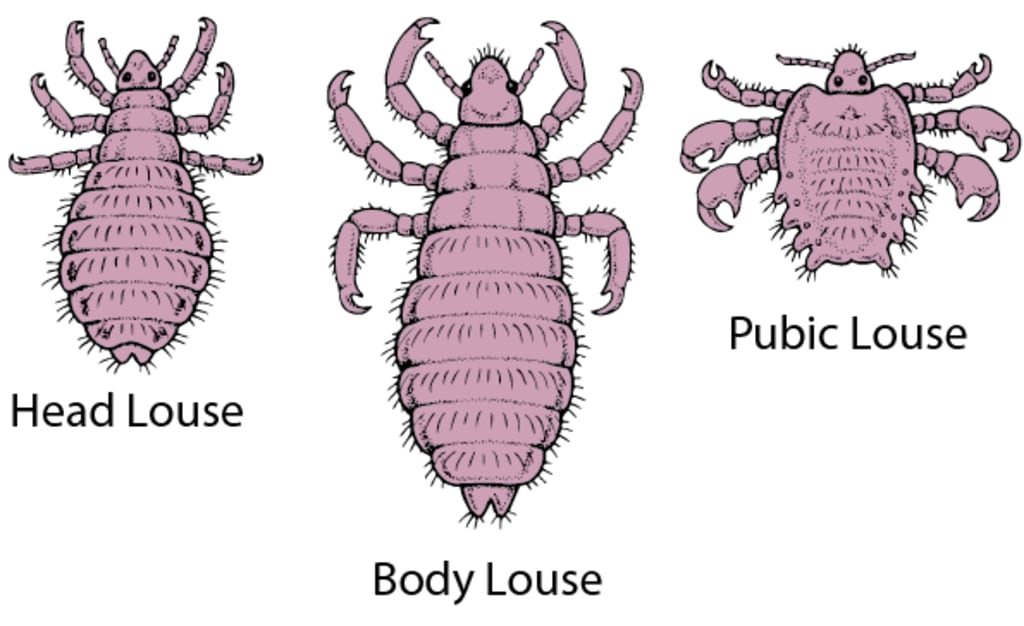LICE
Lice are tiny parasitic insects that feed on human blood. They are typically found on the scalp and lay their eggs, called nits, close to the scalp where the temperature is warmest. Lice are most commonly spread through close personal contact, such as sharing combs, brushes, hats, or other personal items.

Lice are tiny parasitic insects that feed on human blood. They are typically found on the scalp and lay their eggs, called nits, close to the scalp where the temperature is warmest. Lice are most commonly spread through close personal contact, such as sharing combs, brushes, hats, or other personal items.
Lice infestations can be treated with over-the-counter or prescription shampoos, creams, and lotions designed to kill the lice and their eggs. It's important to follow the instructions carefully and to treat all members of the household who may have come in close contact with the person who has lice.
Preventing lice infestations includes avoiding sharing personal items with others, especially combs, brushes, and hats. Regularly washing bedding, clothing, and other personal items can also help prevent the spread of lice.
How to get rid of lice?
Getting rid of lice involves a combination of treating the infested person and their environment, and taking steps to prevent the spread of lice to others. Here are the steps you can take to get rid of lice:
Use a lice treatment product: There are several over-the-counter and prescription products available that are specifically designed to kill lice and their eggs. Follow the instructions carefully and apply the product to dry hair. Be sure to cover the entire scalp and hair, and leave the product on for the recommended amount of time before rinsing it out.
Comb out the nits: After using a lice treatment product, use a fine-toothed comb to remove any remaining nits (lice eggs) from the hair. Wet the hair first and divide it into sections. Comb each section carefully, wiping the comb on a tissue or cloth after each stroke.
Wash all bedding, clothing, and personal items: Wash all clothing, bedding, and other personal items that the infested person has come in contact with in hot water (130°F or higher) and then dry them on high heat. Items that cannot be washed should be sealed in plastic bags for two weeks to suffocate any remaining lice.
Vacuum the environment: Vacuum carpets, furniture, and other surfaces in the infested person's environment to remove any lice or eggs that may have fallen off the person.
Repeat the treatment: Lice treatments should be repeated after 7-10 days to ensure any newly hatched lice are killed.
Take preventive measures: To prevent re-infestation, avoid sharing personal items like combs, brushes, hats, and towels. Encourage children to keep their heads away from other children’s heads during playtime or socializing.
It's important to treat all members of the household who may have come in close contact with the person who has lice, even if they don't show any signs of infestation.
Causes of lice on scalp
Lice infestations on the scalp are caused by tiny parasitic insects that feed on human blood. The most common type of lice found on the scalp is called head lice (Pediculus humanus capitis).
Lice are typically spread through close personal contact with an infested person, such as sharing combs, brushes, hats, or other personal items. They can also be spread through contact with infested bedding, clothing, or furniture.
Other factors that can increase the risk of getting head lice include:
Being in close proximity to someone who has lice, such as in schools or daycare centers.
Having long hair, as lice can more easily attach to longer hair.
Having poor personal hygiene, although lice can infest anyone regardless of their hygiene habits.
Having a weakened immune system, which can make a person more susceptible to infestation.
Sharing personal items like hair accessories, helmets, and headphones with others.
It's important to note that having head lice does not mean a person is dirty or unclean. Anyone can get lice, regardless of their personal hygiene habits





Comments
There are no comments for this story
Be the first to respond and start the conversation.